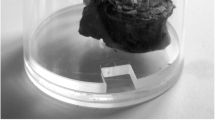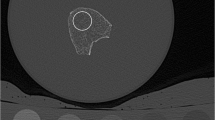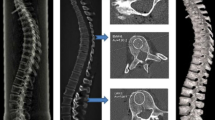Abstract
Summary
Trabecular bone microstructure was studied in 6 mm bone biopsies taken from the 10th thoracic and 2nd lumbar vertebra of 165 human donors and shown to not differ significantly between these sites. Microstructural parameters at the locations examined provided only marginal additional information to quantitative computed tomography in predicting experimental failure strength.
Introduction
It is unknown whether trabecular microstructure differs between thoracic and lumbar vertebrae and whether it adds significant information in predicting the mechanical strength of vertebrae in combination with QCT-based bone density.
Methods
Six mm cylindrical biopsies taken at mid-vertebral level, anterior to the center of the thoracic vertebra (T) 10 and the lumbar vertebra (L) 2 were studied with micro-computed tomography (μCT) in 165 donors (age 52 to 99 years). The segment T11-L1 was examined with QCT and tested to failure using a testing machine.
Results
The correlation of microstructural properties was moderate between T10 and L2 (r ≤ 0.5). No significant differences were observed in the microstructural properties between the thoracic and lumbar spine, nor were sex differences at T10 or L2 observed. Cortical/subcortical density of T12 (r 2 = 48%) was more strongly correlated with vertebral failure stress than trabecular density (r 2 = 32%). BV/TV (of T10) improved the prediction by 52% (adjusted r 2) in a multiple regression model.
Conclusion
Microstructural properties of trabecular bone biopsies displayed a high degree of heterogeneity between vertebrae but did not differ significantly between the thoracic and lumbar spine. At the locations examined, bone microstructure only marginally improved the prediction of structural vertebral strength beyond QCT-based bone density.



Similar content being viewed by others
References
Albright F, Smith PH, Richardson AM (1941) Postmenopausal osteoporosis. JAMA 116:2465–2474
Cooper C, Atkinson EJ, O’Fallon WM et al (1992) Incidence of clinically diagnosed vertebral fractures: a population-based study in Rochester, Minnesota, 1985–1989. J Bone Miner Res 7:221–227
Melton LJ, III, Kan SH, Frye MA et al (1989) Epidemiology of vertebral fractures in women. Am J Epidemiol 129:1000–1011
Felsenberg D (2002) The European Prospective Osteoporosis Study (EPOS) group. Incidence of vertebral fracture in europe: results from the European Prospective Osteoporosis Study (EPOS). J Bone Miner Res 17:716–724
Leidig-Bruckner G, Minne HW, Schlaich C et al (1997) Clinical grading of spinal osteoporosis: quality of life components and spinal deformity in women with chronic low back pain and women with vertebral osteoporosis. J Bone Miner Res 12:663–675
Lips P, Cooper C, Agnusdei D et al (1999) Quality of life in patients with vertebral fractures: validation of the Quality of Life Questionnaire of the European Foundation for Osteoporosis (QUALEFFO). Working party for quality of life of the european foundation for osteoporosis. Osteoporos Int 10:150–160
Ettinger B, Black DM, Nevitt MC et al (1992) Contribution of vertebral deformities to chronic back pain and disability. The study of osteoporotic fractures research group. J Bone Miner Res 7:449–456
Kado DM, Duong T, Stone KL et al (2003) Incident vertebral fractures and mortality in older women: a prospective study. Osteoporos Int
Naves M, Diaz-Lopez JB, Gomez C et al (2003) The effect of vertebral fracture as a risk factor for osteoporotic fracture and mortality in a Spanish population. Osteoporos Int 14:520–524
Hasserius R, Karlsson MK, Nilsson BE et al (2003) Prevalent vertebral deformities predict increased mortality and increased fracture rate in both men and women: a 10-year population-based study of 598 individuals from the Swedish cohort in the European Vertebral Osteoporosis Study. Osteoporos Int 14:61–68
Cooper C (1997) The crippling consequences of fractures and their impact on quality of life. Am J Med 103:12S–17S
Härmä M, Heliovaara M, Aromaa A et al (1986) Thoracic spine compression fractures in Finland. Clin Orthop 188–194
De Smet AA, Robinson RG, Johnson BE et al (1988) Spinal compression fractures in osteoporotic women: patterns and relationship to hyperkyphosis. Radiology 166:497–500
Cockerill W, Ismail AA, Cooper C et al (2000) Does location of vertebral deformity within the spine influence back pain and disability? European Vertebral Osteoporosis Study (EVOS) Group. Ann Rheum Dis 59:368–371
Ismail AA, Cooper C, Felsenberg D et al (1999) Number and type of vertebral deformities: epidemiological characteristics and relation to back pain and height loss. European Vertebral Osteoporosis Study Group. Osteoporos Int 9:206–213
Amling M, Posl M, Ritzel H et al (1996) Architecture and distribution of cancellous bone yield vertebral fracture clues. A histomorphometric analysis of the complete spinal column from 40 autopsy specimens. Arch Orthop Trauma Surg 115:262–269
Hildebrand T, Laib A, Müller R et al (1999) Direct three-dimensional morphometric analysis of human cancellous bone: microstructural data from spine, femur, iliac crest, and calcaneus. J Bone Miner Res 14:1167–1174
Eckstein F, Matsuura M, Kuhn V et al (2007) Sex differences of human trabecular bone microstructure in aging are site-dependent. J Bone Miner Res 22:817–824
Cheng XG, Lowet G, Boonen S et al (1998) Prediction of vertebral and femoral strength in vitro by bone mineral density measured at different skeletal sites. J Bone Miner Res 13:1439–1443
Ebbesen EN, Thomsen JS, Beck-Nielsen H et al (1999) Lumbar vertebral body compressive strength evaluated by dual-energy X-ray absorptiometry, quantitative computed tomography, and ashing. Bone 25:713–724
Lochmüller EM, Bürklein D, Kuhn V et al (2002) Mechanical strength of the thoracolumbar spine in the elderly: prediction from in situ dual-energy X-ray absorptiometry, quantitative computed tomography (QCT), upper and lower limb peripheral QCT, and quantitative ultrasound. Bone 31:77–84
Eckstein F, Fischbeck M, Kuhn V et al (2004) Determinants and heterogeneity of mechanical competence throughout the thoracolumbar spine of elderly women and men. Bone 35:364–374
Bauer JS, Issever AS, Fischbeck M et al (2004) [Multislice-CT for structure analysis of trabecular bone - a comparison with micro-CT and biomechanical strength]. Rofo 176:709–718
Teo JC, Si-Hoe KM, Keh JE et al (2006) Relationship between CT intensity, micro-architecture and mechanical properties of porcine vertebral cancellous bone. Clin Biomech (Bristol , Avon ) 21:235–244
Ito M, Ikeda K, Nishiguchi M et al (2005) Multi-detector row CT imaging of vertebral microstructure for evaluation of fracture risk. J Bone Miner Res 20:1828–1836
Link TM, Bauer J, Kollstedt A et al (2004) Trabecular bone structure of the distal radius, the calcaneus, and the spine: which site predicts fracture status of the spine best? Invest Radiol 39:487–497
Patel PV, Prevrhal S, Bauer JS et al (2005) Trabecular bone structure obtained from multislice spiral computed tomography of the calcaneus predicts osteoporotic vertebral deformities. J Comput Assist Tomogr 29:246–253
Waldt S, Meier N, Renger B et al (1999) Strukturanalyse hochauflösender Computertomogramme als ergänzendes Verfahren in der Osteoporosediagnostik: in-vitro-Untersuchungen an Wirbelsäulensegmenten. Röfo Fortschr Röntgenstr 171:136–142
Muller R, Hannan M, Smith SY et al (2004) Intermittent ibandronate preserves bone quality and bone strength in the lumbar spine after 16 months of treatment in the ovariectomized cynomolgus monkey. J Bone Miner Res 19:1787–1796
Genant HK, Jergas M (2003) Assessment of prevalent and incident vertebral fractures in osteoporosis research. Osteoporos Int 14 (3):S43–S55
Nägele E, Kuhn V, Vogt H et al (2004) Technical considerations for microstructural analysis of human trabecular bone from specimens excised from various skeletal sites. Calcif Tissue Int 75:15–22
Thomsen JS, Ebbesen EN, Mosekilde L (2002) Zone-dependent changes in human vertebral trabecular bone: clinical implications. Bone 30:664–669
Gong H, Zhang M, Yeung HY et al (2005) Regional variations in microstructural properties of vertebral trabeculae with aging. J Bone Miner Metab 23:174–180
Hildebrand T, Rüegsegger E (1997) Quantification of bone microarchitecture with the structure model index. Comp Meth Biomech Biomed Eng 1:15–23
Kalender WA, Klotz E, Suess C (1987) Vertebral bone mineral analysis: an integrated approach with CT. Radiology 164:419–423
Sandor T, Felsenberg D, Kalender WA et al (1992) Compact and trabecular components of the spine using quantitative computed tomography. Calcif Tissue Int 50:502–506
Bürklein D, Lochmüller EM, Kuhn V et al (2001) Correlation of thoracic and lumbar vertebral failure loads with in situ vs. ex situ dual energy X-ray absorptiometry. J Biomech 34:579–587
Moro M, Hecker AT, Bouxsein ML et al (1995) Failure load of thoracic vertebrae correlates with lumbar bone mineral density measured by DXA. Calcif Tissue Int 56:206–209
Homminga J, Van Rietbergen B, Lochmuller EM et al (2004) The osteoporotic vertebral structure is well adapted to the loads of daily life, but not to infrequent “error” loads. Bone 34:510–516
Eswaran SK, Gupta A, Adams MF et al (2006) Cortical and trabecular load sharing in the human vertebral body. J Bone Miner Res 21:307–314
Riggs BL, Melton IL III, Robb RA et al (2004) Population-based study of age and sex differences in bone volumetric density, size, geometry, and structure at different skeletal sites. J Bone Miner Res 19:1945–1954
Sigurdsson G, Aspelund T, Chang M et al (2006) Increasing sex difference in bone strength in old age: The age, gene/environment susceptibility-Reykjavik study (AGES-REYKJAVIK). Bone 39:644–651
Ebbesen EN, Thomsen JS, Beck-Nielsen H et al (1999) Age- and gender-related differences in vertebral bone mass, density, and strength. J Bone Miner Res 14:1394–1403
Van Rietbergen B, Huiskes R, Eckstein F et al (2003) Trabecular bone tissue strains in the healthy and osteoporotic human femur. J Bone Miner Res 18:1781–1788
Pistoia W, Van Rietbergen B, Lochmüller EM et al (2002) Estimation of distal radius failure load with micro-finite element analysis models based on three-dimensional peripheral quantitative computed tomography images. Bone 30:842–848
Acknowledgments
We would like to thank Volker Kuhn, Department of Gynecology I & Musculoskeletal Research Group, Institute of Anatomy, Ludwig-Maximilians-Universität München, Germany for his help with the μCT scans and the mechanical testing, and Mathias Priemel, Dept. of Trauma Surgery, Hamburg University School of Medicine, Hamburg, Germany, for performing the histological examinations of the iliac crest specimens. Gudrun Goldmann is to be acknowledged for her help with radiography and in preparing the iliac crest specimens for histological examination.
Funding
This work has been supported by a grant from the German Research Society (Deutsche Forschungsgemeinschaft; DFG LO 730/3-1).
Author information
Authors and Affiliations
Corresponding author
Rights and permissions
About this article
Cite this article
Lochmüller, EM., Pöschl, K., Würstlin, L. et al. Does thoracic or lumbar spine bone architecture predict vertebral failure strength more accurately than density?. Osteoporos Int 19, 537–545 (2008). https://doi.org/10.1007/s00198-007-0478-x
Received:
Accepted:
Published:
Issue Date:
DOI: https://doi.org/10.1007/s00198-007-0478-x




